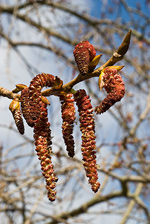|
||||||
|
POPULUS. Poplars and Aspens. [Salicaceae] |
|
|
Ten species of Populus are recorded in Britain. These include the native Black-poplar (P. nigra), White Poplar (P. alba) and Aspen (P. tremula) and the introduced American Aspen (P. tremuloides), Eastern Balsam-poplar (P. balsamifera) and Western Balsam-poplar (P. trichocarpa). The BSBI provide a downloadable plant crib for Populus. Thirty-two miners are recorded on Populus. The agromyzid Hexomyza schineri is recorded in Britain and elsewhere forming twig galls on Populus. A key to the European miners recorded on Populus is provided in Bladmineerders van Europa. |
|
Key for the identification of the known mines of British |
Note: Diptera larvae may live in a corridor mine, a corridor-blotch mine, or a blotch mine, but never in a case, a rolled or folded leaf, a tentiform mine or sandwiched between two more or less circular leaf sections in later instars. Pupation never in a cocoon. All mining Diptera larvae are leg-less maggots without a head capsule (see examples). They never have thoracic or abdominal legs. They do not have chewing mouthparts, although they do have a characteristic cephalo-pharyngeal skeleton (see examples), usually visible internally through the body wall. The larvae lie on their sides within the mine and use their pick-like mouthparts to feed on plant tissue. In some corridor miners frass may lie in two rows on alternate sides of the mine. In order to vacate the mine the fully grown larva cuts an exit slit, which is usually semi-circular (see Liriomyza huidobrensis video). The pupa is formed within the hardened last larval skin or puparium and as a result sheaths enclosing head appendages, wings and legs are not visible externally (see examples). See Key to non-Diptera. |
1a > Leaf-miner: Blotch mine. |
1b > Leaf-miner: Linear mine. |
| 2a > Leaf-miner: Larva
forming a greenish-black blotch mine (Spencer,
1976: 92), which quickly turns brown, frequently several larvae
feed together (Spencer, 1972b:
42).
Elongated, upper-surface blotch, on Poplars much larger than on Willows. At first the colour is green, but this quickly turns into an opaque brown. The larvae distinguish these mines from those of Leucoptera sinuella and Zeugophora species. They are yellow, and often live communal. They leave the mine before pupation; the exit slit is in the upper epidermis. |
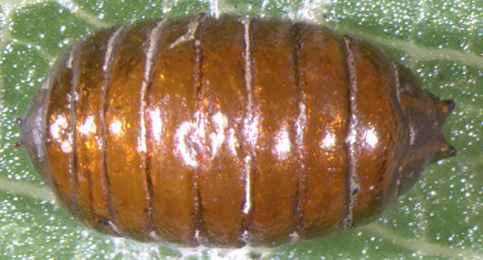 Agromyza albitarsis puparium Image: © Willem Ellis (Bladmineerders van Europa) |
|
Agromyza albitarsis Meigen, 1830 [Diptera: Agromyzidae]. |
2b > Leaf-miner: A shallow, greenish upper surface blotch-mine, which can be somewhat elongate but never obviously linear. Pupation external (Spencer, 1976: 321 (fig. 581), 322). Irregular, yellowish green, upper-surface blotch. Pupation outside the mine; exit slit in upper epidermis. The exit slit is unusually long: from half to almost three quarters of a circle. Frass in rather few, coarse grains. The mine is also illustrated in and British leafminers. |
|
Aulagromyza populicola (Haliday, 1853) [Diptera: Agromyzidae]. |
3a > Leaf-miner: A long winding, whitish linear mine, initially lower surface, later upper surface. Pupation takes place within the leaf, in a distinct puparial blister, the anterior spiracles projecting through the epidermis (Spencer, 1976: 320-1, fig. 578). Yellowish, tortuous corridor with the sides very untidily eaten out. The mine frequently starts at the lower surface, mostly, but by no means always, turning upper-surface later on. Frass in isolated grains, irregularly distributed at either side of the corridor. Puparium brown, in a widened puparial chamber in the mine; near the frontal end of the puparium the epidermis is already more or less torn open. A long winding white gallery (as shown), starting lower side, shallow and going upper side, broad. The mines may not be upper surface and in some cases may be totally lower surface. There may be several mines in a leaf. |
|
Aulagromyza populi (Kaltenbach, 1864) [Diptera: Agromyzidae]. |
3b > Leaf-miner: A short, broad, irregular linear mine, exclusively in the spongy parenchyma, on underside of leaf. Pupation external (Spencer, 1976: 323, 325 (fig. 585)). Yellowish, lower-surface corridor with irregular sides. Frass in fine grains, irregularly scattered. Pupation outside the mine, exit slit in lower epidermis. A long winding lower surface gallery. The mine of A.populi is similar, but the pupation is in the mine in this species. A.populi mines are partly, sometimes fully, upperside, whereas A.tremulae mines are lower surface. |
|
Aulagromyza tremulae (Hering, 1957) [Diptera: Agromyzidae]. |
|
Key for the identification of the known mines of British |
Note: The larvae of mining Coleoptera, Hymenoptera and Lepidoptera may live in a corridor mine, a corridor-blotch mine, a blotch mine, a case, a rolled or folded leaf, a tentiform mine or sandwiched between two more or less circular leaf sections in later instars. Larva may pupate in a silk cocoon. The larva may have six legs (although they may be reduced or absent), a head capsule and chewing mouthparts with opposable mandibles (see video of a gracillarid larva feeding). Larvae of Hymenoptera and Lepidoptera usually also have abdominal legs (see examples). Frass, if present, never in two rows. Unless feeding externally from within a case the larva usually vacates the mine by chewing an exit hole. Pupa with visible head appendages, wings and legs which lie in sheaths (see examples). |
1a > Leaf-miner and case-bearer: The larva lives outside the mine, protected by a case, and feeds on the underlying plant tissues via a hole cut in the epidermis. From that point it eats away as much leaf tissue as it can reach without fully entering the mine. Mine does not contain frass (Coleophora species) |
1b > Leaf-miner or galler, but not a case-bearer: The larva lives mainly inside the mine. Mine usually contains frass. In later instars the larva may live sandwiched between two more or less circular sections cut from the leaf. |
2 > Leaf-miner and case-bearer: The larva feeds by inserting its head into small mines it creates on the leaves of birch, elm, alder, or hazel. Occasionally it is found feeding on other trees, or on herbaceous plants onto which it has accidentally Fallén. It forms two cases during its larval life. The first case is initially curved, smooth, laterally compressed with a bivalved anal opening, and about 2 mm long in September. During October it feeds, and adds a few rough collars of larval material around the oral opening. After hibernation, it feeds again in April and early May, adding more protruding collars until they equal or exceed the original smooth part of the case. At the same time, it expands the case girth by the creation of a silk gusset ventrally. The second case, 6 or 7 mm long, is formed in May, leaving the vacated first case attached to its last feeding mine. The new case is tubular with a trivalved crimp at the anal opening. The dorsum is formed from the edge of the leaf from which the case was cut. This results in a more or less serrated dorsal keel, depending on the plant species and the individual piece of leaf used. Considerable variation in the degree of serration can be found, even among specimens off the same tree. The case colour varies with food plant, from yellowish brown on birch, darkening through elm and hazel to dark brown on alder. The strongly curved young case is is a composite leaf case, the adult case is a tubular leaf case. The adult case is bivalved, about 7 mm in length; the mouth angle is around 30°. The case is straw coloured and almost always has a toothed dorsal keel (remnant of the margin of the leaf from which the case was cut). Neither larvae or cases of C. coracipennella, prunifoliae, serratella and spinella can be separated; from serratella. |
|
Coleophora serratella (Linnaeus 1761) [Lepidoptera: Coleophoridae]. |
3a > Galler and Leaf-miner: A gall in petiole, later mine in leaf-blade, in 'green island'. The egg is placed on the petiole, about a cm below the base of the leaf; often one egg at either side. The larva first bores in the distal part of the petiole, that shows a local swelling. When the larva reaches the leaf it makes an elongate triangular blotch between the leaf margin and the first side vein, or, less frequently, between midrib and side vein. Frass in two bands, parallel to the sides of the mine, created by the passage of the larva when it retreates into the petiole. The larva mainly feeds at night. Pupation external. |
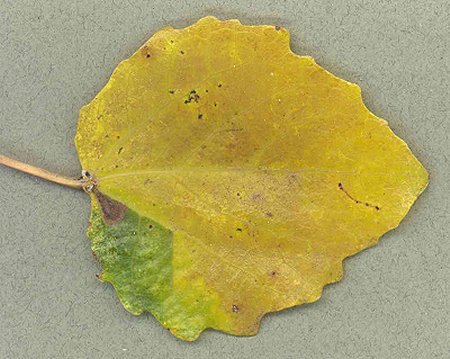 Mine of Ectoedemia turbidella on Populus x canescens Image: © David Manning (British leafminers) |
|
Ectoedemia turbidella (Zeller, 1848) [Lepidoptera: Nepticulidae]. |
3b >Galler and Leaf-miner: Gall in petiole, later mine in leaf-blade, in 'green island'. Oviposition on the petiole, c. 1 cm below the base of the leaf. The larva begins its life as a borer in the petiole, causing it to swell somewhat. When the leaf disc is reached the larva makes an elongate blotch between the midrib and the first lateral vein. Frass in two stripes parallel to the sides of the mine. Pupation external. The larvae are active mainly at night, retreating into the petiole during daytime (Johansson et al., 1990a). |
|
Ectoedemia argyropeza (Zeller, 1839) [Lepidoptera: Nepticulidae]. |
3c > Galler and Leaf-miner: The initial mine is in the leaf petiole and later the mines form green islands in the leaf. Oviposition in the petiole, c. a cm below the base of the leaf. The larva begins its life as a borer in the petiole, causing it to locally swell somewhat. Once the larva has reached the leaf disc it begins forming an elongate blotch between the leaf margin and the most lateral vein, or, more rarely, between the midrib and the first lateral vein. Frass in two stripes, parallel to the sides of the mine. Pupation external. The larvae feed only at night, retreating within the petiole at daytime. The larva can be lured into the mine by keeping the leaf in the dark for a while (Borkowski, 1969a). The arrangement of the frass in two stripes is the result of the regular movement of the larva. |
|
Ectoedemia hannoverella (Glitz, 1872) [Lepidoptera: Nepticulidae]. |
3d > Leaf-miner: Initially a lower epidermal gallery which leads to a blotch at the leaf-edge. Subsequently creates two or three cones by folding the edge or tip of a leaf downwards. The mine begins with an unusually long lower-surface epidermal corridor that often follows the midrib for some distance, but finally turns towards the leaf margin, where a small blotch is made of up to 1 cm in diameter. The blotch initially is fully epidermal, but later the larva starts consuming parenchyma, silk is deposited, and the blotch begins to develop into a somewhat contracted tentiform mine. In the end the mine is vacated and the larva continues living freely under a leaf fold that has been fixed with silk, or in a leaf tip that has been turned into a cone. Pupation in a shiny cocoon at the underside of the leaf. |
|
Caloptilia stigmatella (Fabricius, 1781) [Lepidoptera: Nepticulidae]. |
3e > Leaf-miner: Transparent blotch, starting at the leaf margin, quickly turning brown. Frass in scattered grains. The larvae of sawflies have at least six thoracic legs (although they may be reduced or absent), a head capsule and chewing mouthparts with opposable mandibles but no abdominal legs. |
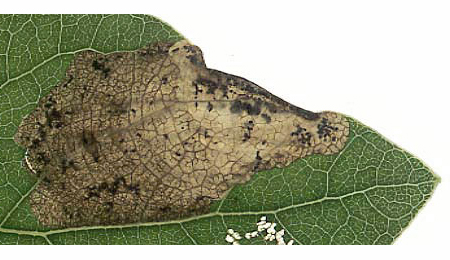 Mine on Fenusella glaucopis on Populus x canescens Image: © Willem Ellis (Bladmineerders van Europa) |
|
Fenusella glaucopis (Konow, 1907) [Hymenoptera: Tenthredinidae]. |
3f > Leaf-miner: transparent blotch, quickly turning brown, starting at the leaf margin. Frass in scattered grains. Care must be taken in identifying this miner as the mines of Fenusella glaucopis can appear similar. The larvae of sawflies have at least six thoracic legs (although they may be reduced or absent), a head capsule and chewing mouthparts with opposable mandibles but no abdominal legs. |
 Fenusella hortulana dead larva (dried and shrivelled), ventral Image: © Willem Ellis (Bladmineerders van Europa) |
|
Fenusella hortulana (Klug, 1818) [Hymenoptera: Tenthredinidae]. |
3g > ? Leaf-miner: The larvae feed on a range of deciduous trees, windowing leaves in autumn and eating the buds, catkins, young shoots and then spun leaves in the spring. Cocoon formed in soil or where the larva fed British leafminers. |
|
Gypsonoma dealbana (Frölich, 1828) [Lepidoptera: Tortricidae]. |
3hi > Leaf-miner: Large, deep, upper-surface blotch that starts at the leaf margin, without an accumulation of frass. Around the oviposition site the leaf turns reddish brown. Frass in scattered grains, but towards the end of the larval period an opening is made in the mine, and both frass and exuvia are ejected. About that time the mined leave is shed, and the larva makes a disk-shaped cocoon within the mine, in which it diapauses until the following spring. The larvae of sawflies have at least six thoracic legs (although they may be reduced or absent), a head capsule and chewing mouthparts with opposable mandibles but no abdominal legs. |
|
Heterarthrus ochropoda (Klug, 1818) [Hymenoptera: Tenthredinidae]. |
3i > Leaf-miner: Almost round, brown to brownish black, upper surface, very opaque blotch, about 1 cm in diameter, without an initial corridor. Upper epidermis leathery in colour. Often several mines in a leaf. All frass as a tar-like film on the floor of the mine. |
|
Isochnus sequensi (Stierlin, 1894) (Stierlin, 1894) [Coleoptera: Curculionidae]. |
3j > Leaf-miner: A 'snail-trail'-like mine on the upper surface, long and sinuous, without any visible frass. The mine can sometimes cover most of the leaf. Very long, broad, epidermal corridor that winds in dense loops over the upperside of the leaf without crossing itself. Frass in a continuous, extremely vague central line. The mine ends at the leaf margin, where the corridor is slightly widened, and in which some silk is deposited. When this dries the the leaf margin somewhat folds over this pupal chamber, since it is here that pupation takes place.The mine has a strong resemblance to the trail of dried mucus left by a small snail, which has given the mine its Dutch name of snail-trail mine. |
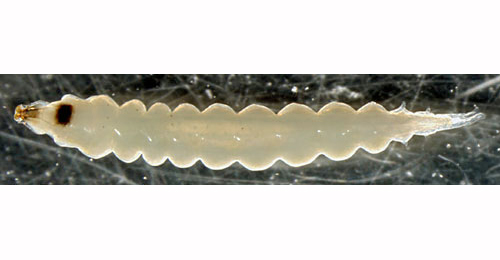 Phyllocnistis unipunctella larva, dorsal Image: © Willem Ellis (Bladmineerders van Europa) |
|
Phyllocnistis unipunctella (Stephens, 1834) [Lepidoptera: Gracillariidae]. |
3k > Leaf-miner: A 'snail-trail'-like mine on the upper surface, long and sinuous, with a dark central frass trail, ending at the leaf margin. Very long, rather broad, strictly epidermal, corridor that curves in dense loops over the leaf upperside, without ever crossing itself. Frass in a vague continuous central line. The gallery ends upon the leaf margin, where it widens a little, while the leaf margin folds over somewhat. Here pupation takes place, not in a cocoon. Under a silk membrane on the margin of leaf. |
|
Phyllocnistis xenia M. Hering, 1936 [Lepidoptera: Gracillariidae]. |
3l > Leaf-miner: An underside mine, with few creases and causing little leaf distortion. Some mottling of the upper leaf surface may be caused. Oval, lower-surface tentiform mine. The lower epidermis has no recognisable folds, and in fact the mine is barely visible in the felty underside of the leaf. Frass heaped in an angle of the mine. Pupa in a barely recognisable flimsy cocoon. |
|
Phyllonorycter comparella (Duponchel, 1843) [Lepidoptera: Gracillariidae]. |
3m > Leaf miner: Large, lower-surface tentiform mine with one sharp fold. Frass in the opposite corner of the mine. |
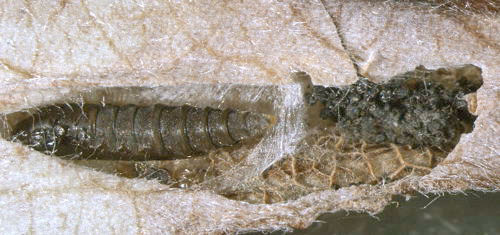 Pupa of Phyllonorycter pastorella in flimsy cocoon Image: Willem Ellis (Bladmineerders van Europa) |
|
Phyllonorycter pastorella (Zeller, 1846) [Lepidoptera: Gracillariidae]. |
3n > Leaf-miner: The lower surface of the mine can have small creases and appear reddish. Lower surface oval tentiform mine, without a fixed position on the leaf. The mine is yellowish, sometimes tinged with red; black when old. Frass stacked in one corner of the mine, the almost black pupa, in a very flimsy cocoon, in the other. |
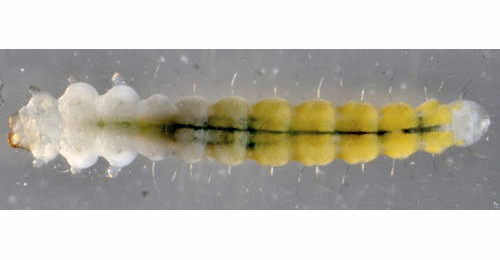 Phyllonorycter sagitella larva, dorsal Image: © Willem Ellis (Bladmineerders van Europa) |
|
Phyllonorycter sagitella (Bjerkander, 1790) [Lepidoptera: Gracillariidae]. |
3o > Leaf-miner: The larvae feed in a blotch on the underside of a leaf of sallow, causing the leaf edge to curl under when at the edge. Fairly small, lower-surface, tentiform mine, often toching the leaf margin. The reddish brown pupa in a flimsy, whitish of very pale yellowish cocoon; possibly the cocoon sometimes is missing altogether. Frass packed in a corner of the mine. Cannot be separated (without opening mine or breeding moths) from mines of other sallow-feeding species. |
|
Phyllonorycter salicicolella (Sircom, 1848) [Lepidoptera: Gracillariidae]. |
| 3p > Leaf-miner: The mine is underside, strongly creased and contracted causing leaf-edge to fold down (British leafminers, as Phyllonorycter salictella viminiella). Rather large, lower-surface tenntiform mine, generally against the leaf margin, often low in the leaf. Lower epidermis strongly folded; the mine is strongly contracted, causing the leaf margin to fold tube-like over the mine. All frass packed in a corner of the mine. Pupa reddish brown, in a light brown cocoon without frass. |
|
|
Phyllonorycter salictella (Zeller, 1846) [Lepidoptera: Gracillariidae]. |
3q > Leaf-miner: Generally small, upper-surface, pear-shaped mines, half of their surface stuffed with frass. In the frass-free part an oval, flattened larva. Often several mines in a leaf. Prior to oviposition the larvae eat, a large number of tiny holes in the leaves. |
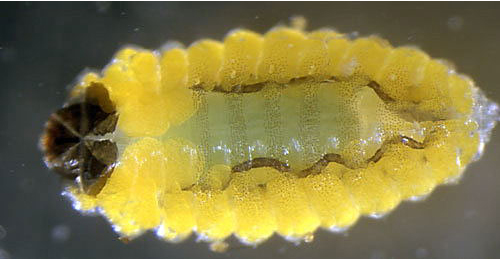 Rhamphus pulicarius larva, dorsal Image: © Willem Ellis (Bladmineerders van Europa) |
|
| Rhamphus pulicarius (Herbst, 1795) [Coleoptera: Curculionidae]. |
3r > Leaf-miner: The initial gallery has clear margins, with broken linear frass. The later mine is a blotch formed by many turns. Oviposition at the leaf upper surface. Mine a densely winding corridor, later sections strongly widened, almost forming a secondary blotch. Frass in a more or less continuous central band that, even in the narrow initial part, never completely fills the corridor. |
|
Stigmella assimilella (Zeller, 1848) [Lepidoptera: Nepticulidae]. |
3s > Leaf-miner: A gallery leading to a blotch. Egg either at upper- or lowerside of the leaf. The mine is a corridor; the first part is rather straight and narrow, and often follows a vein for some length; the second part is much broader, sometimes almost a blotch. In the first part of the mine the frass lies in a more or less uninterrupted central line that does not occupy the full with of the gallery; in the second part the frass pattern is very variable, ranging from a narrow central line to a broad band. |
|
Stigmella trimaculella (Haworth, 1828) [Lepidoptera: Nepticulidae]. |
3t > Leaf-miner: All western European Zeugophora miners make large, blackish brown, upper-surface blotch. Oviposition at the leaf underside, in a small pit, that is covered by secretion. These oviposition marks remain visible as small, transparent points. The larvae of Zeugophora species are yellow, flattened, and. They live communal, and leave the mine through an upper-surface exit slit. |
|
Zeugophora flavicollis (Marsham, 1802) [Coleoptera: Chrysomelidae]. |
3u > Leaf-miner: All western European Zeugophora make large, blackish brown, upper-surface blotch. Oviposition at the leaf underside, in a small pit, that is covered by secretion. These oviposition marks remain visible as small, transparent points. The larvae of Zeugophora species are yellow and flattened. They live communal, and leave the mine through an upper-surface exit slit. |
 Mines of Zeugophora subspinosa Image: John Lamin |
|
Zeugophora subspinosa (Fabricius, 1781) [Coleoptera: Chrysomelidae]. |
3v > Leaf-miner: All western European Zeugophora make large, blackish brown, upper-surface blotch. Oviposition at the leaf underside, in a small pit, that is covered by secretion. These oviposition marks remain visible as small, transparent points. The larvae of Zeugophora species are yellow and flattened. They live communal, and leave the mine through an upper-surface exit slit. |
|
Zeugophora turneri Power, 1863 [Coleoptera: Chrysomelidae]. |
3w > Leaf-miner: Full depth, broad, transparent, brown, corridor that descends from the leaf tip along tje leaf margin. Frass in a stripe along the outer side of the mine. The mine ends in a round excision. |
|
Tachyerges decoratus (Germar, 1821) [Coleoptera: Curculionidae]. |
3x > Leaf-miner: A large, full depth transparent light brown blotch that expands irrespective of the leaf venation. Mine mostly in the distal half of the leaf, may eventually occupy half of its surface. The mine often tears in, and the leaf tip is disfigured. Forms a blotch mine at a leaf tip and can distort the leaf. The mine may occupy half the leaf. |
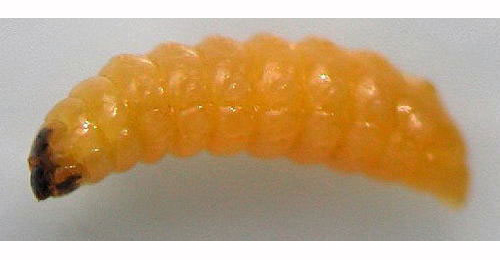 Tachyerges salicis larva, dorsal Image: © Rob Edmunds (Bladmineerders van Europa) |
|
Tachyerges salicis (Linnaeus, 1758) [Coleoptera: Curculionidae]. |
3y > Leaf-miner: Oviposition in the base of the midrib, without giving rise to an oviposition scar. The larva initially bores inside the midrib. Later it leaves the midrib, forming a broad corridor in the blade, that widens into a blotch. Finally the larva pupates in a globular cocoon inside the mine. Because the mine develops at a time that the leaf is fully developed, mined leaves are not disfigured. |
|
Tachyerges stigma (Germar) [Coleoptera: Curculionidae]. |
3z > Leaf-miner: Full depth corridor, beginning at the base of the midrib and very roughly following the leaf margin; all the while the corridor widens, until almost the entire leaf has been mined out. Frass, as coarse grains or thread fragments, in the centre of the mine. The larva pupates in the mine, in a globular cocoon made of secretion. |
|
Tachyerges pseudostigma (Tempère, 1982) [Coleoptera: Curculionidae]. |
| Last updated 06-Jul-2019 Brian Pitkin | ||

